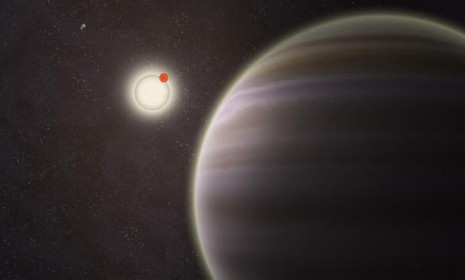The newly discovered Star Wars-like planet with four suns
Luke Skywalker's home of Tatooine, with its two suns, is suddenly more than just science fiction

Many solar systems, including our own, have multiple planets orbiting a centralized star like the sun. But until very recently, the thought of a single planet orbiting multiple stars at once seemed not only improbable but something very much in the realm of science fiction. Yet a remarkable new exoplanet discovered by a team of amateur astronomers has the extremely rare distinction of rotating around four stars simultaneously, earning the strange planet comparisons to Tatooine — Star Wars character Luke Skywalker's planetary home that famously featured two setting suns. Here's what you need to know about the strange new world:
What is this planet?
The planet, which is 3,200 light-years away, has been dubbed PH1 (Planet Hunters 1) and is thought to be a gas giant 6.2 times larger than Earth, says Adam Mann at Wired. Whereas Star Wars' Tatooine is a circumbinary planet that revolves around a set of binary stars, PH1's solar system does it one better, containing a second far-off star-set. "Scarcely a year ago, astronomers weren't sure if planets could exist in binary star systems, where two stars orbit one another," says Mann. It's why the quadruple star system, officially named KIC 4862625, is considered such a huge discovery.
The Week
Escape your echo chamber. Get the facts behind the news, plus analysis from multiple perspectives.

Sign up for The Week's Free Newsletters
From our morning news briefing to a weekly Good News Newsletter, get the best of The Week delivered directly to your inbox.
From our morning news briefing to a weekly Good News Newsletter, get the best of The Week delivered directly to your inbox.
How do the four suns co-exist, though?
In the center of the system is a pair of binary stars that function similarly to the sun in our solar system. Like Earth, the Neptune-sized PH1 orbits around the pair. But in the outer stretches of the star system sits another pair of binary stars. This second pair also rotates around the system's centralized "suns."
What would someone on the planet see looking up?
If someone were to theoretically stand on PH1, they'd see a "double sunset as well as two extremely bright stars far off in the night sky," says the Daily Mail. Every 138 days or so, the planet would pass in front of its parent stars and experience an eclipse.
A free daily email with the biggest news stories of the day – and the best features from TheWeek.com
Who found PH1?
Amateur scientists Kian Jek of San Francisco and Robert Gagliano of Cottonwood, Ariz., spotted it while sifting through publicly available data from NASA's $600 million Kepler telescope at the website Planethunters.org. They said they noticed "anomalies" in the way the stars' light flickered "that confirmed existence of the special planet," says Ed Payne at CNN. Their findings were confirmed by Yale researchers and have been submitted to The Astrophysical Journal for publication.
What do other scientists think about it?
"I celebrate the discovery for the wow-factor of a planet in a four-star system," says Natalie Batalha, a Kepler scientist at NASA. "But more importantly, I celebrate this discovery as the fruit of exemplary human cooperation... between scientists and citizens who give of themselves for the love of stars, knowledge, and exploration."
Sources: CNN, Daily Mail, Space.com, Wired
-
 Political cartoons for December 14
Political cartoons for December 14Cartoons Sunday's political cartoons include a new White House flag, Venezuela negotiations, and more
-
 Heavenly spectacle in the wilds of Canada
Heavenly spectacle in the wilds of CanadaThe Week Recommends ‘Mind-bending’ outpost for spotting animals – and the northern lights
-
 Facial recognition: a revolution in policing
Facial recognition: a revolution in policingTalking Point All 43 police forces in England and Wales are set to be granted access, with those against calling for increasing safeguards on the technology